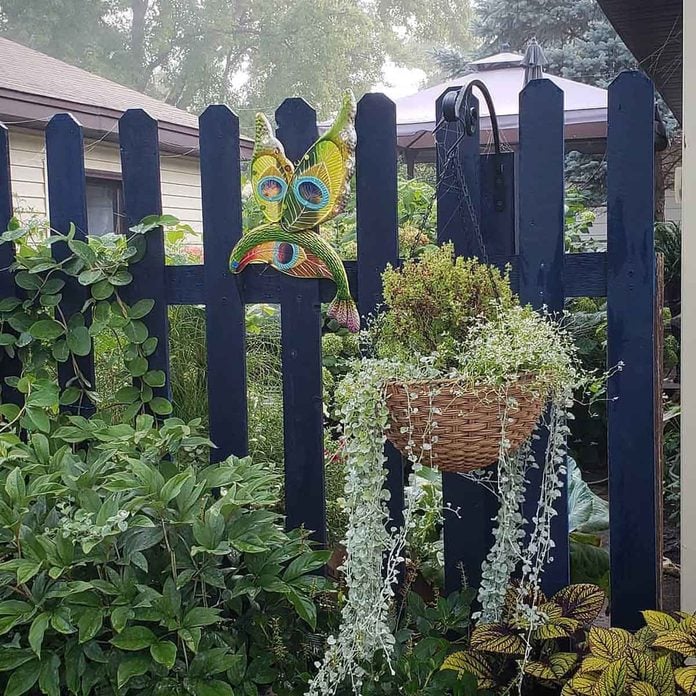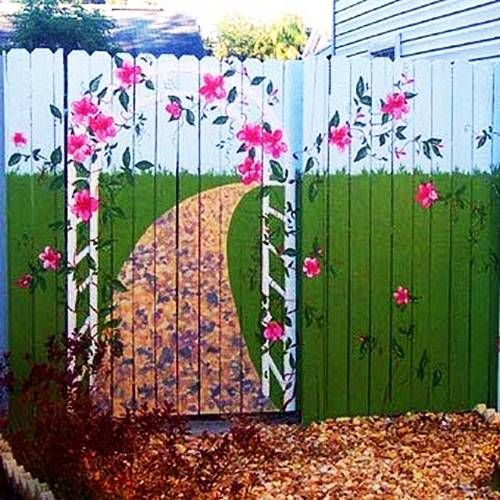Are you looking to freshen up your fence and give it a brand new appearance? Well, you’ve come to the right place! In this article, we’re going to explore some fantastic fence painting ideas that will transform your outdoor space. Whether you’re looking to add a pop of color, create a rustic look, or simply protect your fence from the elements, we’ve got you covered. By the end of this article, you’ll have plenty of inspiration and tips to bring your fence to life.
When it comes to fence painting, the possibilities are endless. You can choose from a wide range of colors to match your home’s exterior or go for something bold and eye-catching. We’ll delve into different color schemes and their effects on the overall appearance of your fence. Not only will we cover the aesthetic aspects, but we’ll also discuss the practical benefits of painting your fence, such as preventing rot and increasing its lifespan. So, get ready to dive into the world of fence painting and give your outdoor space a fresh and inviting look. Stay tuned to the upcoming articles where we’ll provide more detailed information and answer any questions you may have about fence painting.
Fence Painting Ideas for a Fresh Appearance
When it comes to improving the look and durability of your fence, painting is a fantastic option. Not only does painting your fence enhance its curb appeal, but it also protects against weather damage and increases your property value. In this article, we will explore the benefits of fence painting and provide you with a comprehensive guide on choosing the right paint color, techniques for painting, creative ideas, maintenance tips, eco-friendly options, safety precautions, and more. Let’s dive right in!

Benefits of Fence Painting
Why paint your fence?
Painting your fence offers numerous benefits that go beyond just aesthetics. By applying a fresh coat of paint, you can protect your fence from weather-related damage and extend its lifespan. Additionally, painting your fence can increase your property’s value and enhance its overall appearance.
Enhances curb appeal
One of the primary reasons homeowners choose to paint their fences is to enhance curb appeal. A beautifully painted fence can instantly transform the look of your property and create a positive first impression. Whether you opt for a classic neutral color or a bold statement hue, a freshly painted fence can make a significant impact on the overall aesthetics of your home.
Protects against weather damage
Exposure to harsh weather conditions can take a toll on your fence, leading to issues such as rotting, warping, or discoloration. However, by painting your fence, you can provide an additional layer of protection against these elements. The paint acts as a barrier, preventing moisture from seeping into the wood or metal and protecting it from UV rays.
Increases property value
A well-maintained fence can significantly increase the value of your property. When potential buyers or appraisers see a freshly painted fence, they perceive it as a sign of a carefully maintained and cared-for property. A painted fence adds that extra touch of polish and can contribute to a higher resale value.
Choosing the Right Paint Color
Selecting the right paint color for your fence is crucial for achieving the desired look and feel. There are several factors to consider when making this decision, including your home’s exterior, blending with the surroundings, color psychology, and more.
Consider your home’s exterior
To create a cohesive and harmonious look, it’s essential to consider your home’s exterior when choosing a paint color for your fence. You can either match the color palette of your house or opt for complementary shades that create a visually appealing contrast. Remember, the goal is to create a seamless transition between your home and the fence.
Blend with the surroundings
Take into account the natural surroundings of your property, such as trees, plants, and other landscaping features. The paint color should complement these elements and blend harmoniously with the environment. For example, if your property is surrounded by lush greenery, earthy tones like olive or moss green can be a great choice.
Bold vs. neutral colors
Deciding between bold and neutral colors ultimately depends on your personal preference and the effect you want to achieve. Bold colors can make a statement and become a focal point of your exterior while adding a touch of personality. On the other hand, neutral shades provide a timeless and elegant look, allowing other elements in your outdoor space to shine.
Color psychology
Understand the psychology behind different colors and how they can influence mood and perception. For instance, shades of blue can evoke a sense of calm and tranquility, making them ideal for creating a relaxing outdoor atmosphere. Yellows and oranges, on the other hand, can add energy and vibrancy to your space.

Fence Painting Techniques
To achieve a professional-looking finish, proper surface preparation and the right tools are crucial. Additionally, understanding the differences between using a brush, roller, or sprayer, along with some painting tips and tricks, can significantly improve your fence painting experience.
Surface preparation
Before painting your fence, thorough surface preparation is essential. Start by cleaning the fence using a mild detergent or a pressure washer to remove dirt, debris, and any loose paint. If your fence has any imperfections, such as chips or cracks, make sure to repair them before applying paint. Sanding the surface can also help create a smooth and even canvas for painting.
Choosing the right tools
Selecting the right tools can make a significant difference in the outcome of your fence painting project. For smaller areas or intricate details, a brush is the best choice as it allows for better control and precision. Rollers are ideal for larger fence surfaces as they cover more area quickly. Sprayers offer a smooth, even finish, but they require skill and practice to avoid overspray.
Brush vs. roller vs. sprayer
Brushes are versatile and can be used for various fence types and sizes. They are handy when it comes to tricky areas such as corners and edges. Rollers, on the other hand, are perfect for flat surfaces and can provide a faster application. Sprayers can give a professional look but require careful handling and proper protective measures to avoid paint drift.
Painting tips and tricks
To achieve a flawless finish, consider the following tips and tricks:
- Start painting from top to bottom to avoid drips and streaks.
- Use long, smooth strokes for an even application.
- Apply multiple thin coats instead of one thick coat to prevent the paint from pooling or running.
- Avoid painting in direct sunlight as it can cause the paint to dry too quickly and result in an uneven finish.
- Blend the newly painted sections with the previously painted areas while the paint is still wet for a seamless look.
Creative Fence Painting Ideas
Painting your fence opens up a world of creative possibilities to elevate its appearance and make a statement. Whether you’re looking to add stripes and patterns or create a mural or artwork, here are some creative fence painting ideas to inspire you.
Stripes and patterns
Adding stripes or patterns to your fence can instantly elevate its visual appeal. Consider alternating colors or different shades of the same color to create a playful and eye-catching design. Stripes can create a sense of movement, while geometric patterns can add a touch of modern elegance to your outdoor space.
Mural or artwork
Transform your fence into a canvas by creating a mural or artwork. Whether you’re a talented artist or prefer to hire a professional, a painted mural can become a stunning focal point in your outdoor area. Choose a theme that resonates with you, such as nature-inspired landscapes, abstract designs, or even a favorite quote.
Faux finishes
If you want to add depth and texture to your fence, consider using faux finishes. Techniques such as wood grain or stone texture can mimic the appearance of different materials, giving your fence a unique and realistic look. Faux finishes are particularly popular for wooden fences, as they can transform them into rustic or aged structures.
Color blocking
Color blocking involves dividing the fence into sections or panels and painting each section a different color. This technique adds visual interest and can create a contemporary and dynamic look. Explore the use of contrasting or complementary colors to make a bold statement or opt for a more subtle effect with shades from the same color family.

Painting Different Types of Fences
Different types of fences require specific considerations and techniques when it comes to painting. Whether you have a wooden, vinyl, metal, or chain-link fence, here are some tips to help you achieve the best results.
Wooden fences
Wooden fences require proper preparation, including sanding and priming, to ensure optimal paint adhesion. Choose a high-quality exterior paint specifically formulated for wood, and consider using a sealer or a clear coat for added protection against moisture and UV rays.
Vinyl fences
Vinyl fences are relatively low-maintenance but can benefit from a fresh coat of paint to enhance their appearance or change their color. It is crucial to choose a paint that is specially designed for use on vinyl surfaces and can withstand the expansion and contraction of the material due to temperature changes.
Metal fences
Metal fences, such as iron or aluminum, require thorough surface preparation to remove any rust or corrosion. Consider using a rust-inhibiting primer before applying paint to provide long-lasting protection. Opt for a high-quality exterior paint that is designed for metal surfaces, and consider adding a clear coat for additional durability.
Chain-link fences
Painting a chain-link fence can be a bit more challenging due to its unique texture. Before painting, it’s essential to clean the fence thoroughly to remove any dirt or debris. A spray paint specifically designed for metal surfaces can provide good coverage and durability for a chain-link fence.
Maintaining and Touching Up Painted Fences
Once you’ve painted your fence, proper maintenance and occasional touch-ups are essential to keep it looking fresh and vibrant. Here are some maintenance tips to help you preserve the beauty of your painted fence.
Regular cleaning
Regularly clean your fence by gently washing it with a mild detergent and water to remove dirt, mold, or mildew. Avoid using harsh chemicals or abrasive cleaners that can damage the paint finish or the fence material. Rinse thoroughly after cleaning and allow the fence to dry completely before applying any touch-up paint.
Inspecting for damage
Periodically inspect your painted fence for any signs of damage, such as chips, cracks, or peeling paint. Address these issues promptly to prevent further deterioration of the paint and to protect the underlying fence material. A thorough inspection will also help identify any structural or safety concerns that may require professional attention.
Repairing chips and cracks
If you notice any chipped or cracked areas on your fence, repair them as soon as possible. Start by sanding the affected area to create a smooth surface. Fill the chips or cracks with an appropriate filler or putty, ensuring it matches the color and texture of the surrounding paint. Once the filler has dried, sand it down to level with the surrounding area, and then touch up the paint.
Applying touch-up paint
To maintain the fresh appearance of your painted fence, apply touch-up paint as needed. Keep a small container of the paint color you used handy for quick and easy touch-ups. Before applying touch-up paint, clean the area thoroughly and feather the edges of the existing paint to create a seamless transition. Apply the touch-up paint using the same technique you used initially.

Eco-Friendly Paint Options for Fences
If you’re concerned about the environmental impact of traditional paints, you’ll be pleased to know that there are several eco-friendly options available. Consider these alternatives for your fence painting project.
Water-based paints
Water-based or latex paints are an eco-friendly choice as they have lower volatile organic compound (VOC) emissions compared to oil-based paints. These paints are also easier to clean up, require less time to dry, and maintain their color and finish for longer periods.
Low-VOC paints
Low-VOC paints are another excellent option for environmentally conscious homeowners. They are formulated with minimal amounts of VOCs, reducing the impact on indoor and outdoor air quality. Low-VOC paints are available in a wide range of colors and finishes, allowing you to achieve the desired look while minimizing harmful emissions.
Natural and non-toxic options
For those looking for completely natural and non-toxic paint options, consider paints made from plant-based or mineral ingredients, such as milk paint or clay paint. These options are free from harmful chemicals and can provide a unique and earthy finish. However, they may require additional maintenance and may not offer the same level of durability as traditional paints.
Recycled paint products
Recycled paint products, also known as reblended or reclaimed paints, are made from surplus or post-consumer paints that have been reprocessed and remixed. These paints are a sustainable choice as they reduce waste and promote the reuse of existing materials. Not only are they eco-friendly, but they also offer a cost-effective solution for fence painting.
Using Stencils and Templates for Fence Painting
If you’re looking to add intricate designs or patterns to your fence, stencils and templates can be valuable tools. Here’s how you can incorporate them into your fence painting project.
Creating intricate designs
Stencils and templates allow you to create detailed and complex designs with ease. From geometric patterns to nature-inspired motifs, you can choose from a wide variety of pre-made stencil designs or even create your own custom templates. Use a contrasting or complementary paint color to make the stenciled design stand out.
Stencil application techniques
When using stencils, it’s important to secure them firmly against the fence and avoid any paint bleed. Fix the stencil in place using painter’s tape or adhesive spray, ensuring it lays flat against the surface. Apply paint using a brush or a sponge, being careful not to overload the paint and causing it to seep under the stencil. Remove the stencil immediately after painting to avoid smudging.
Project ideas for stenciled fences
Stencils offer endless creative possibilities for giving your fence a unique touch. Consider stenciling a border design along the top of your fence, adding a repeating pattern to create a sense of movement, or even stenciling individual motifs like flowers or birds. Let your imagination run wild and personalize your fence according to your style and preferences.
Customizing with templates
Templates allow you to create personalized designs and shapes. You can use them to paint your house number or address on your fence, add your favorite quotes or lyrics, or even create silhouettes of beloved pets or objects. Templates provide an opportunity for self-expression and can turn your fence into a true reflection of your personality and interests.

DIY vs. Hiring a Professional
When it comes to fence painting, you may choose to tackle the project yourself or hire a professional. Both options have their pros and cons, and it’s important to consider various factors before making a decision.
Cost considerations
Painting your fence yourself can be a cost-effective option, especially if you already have the necessary tools and equipment. Hiring a professional, on the other hand, involves additional expenses but can ensure a high-quality finish. Consider your budget and the complexity of the project when determining which option is the best fit for you.
Time and effort required
Painting a fence can be a time-consuming and physically demanding task, especially if you have a large property or intricate details to work around. Assess your available time and energy levels before deciding whether to tackle the project yourself or leave it in the hands of professionals.
Quality of finish
Professionals have the expertise and experience to provide a flawless finish, ensuring every detail is taken care of. If you want the highest level of quality and want to avoid any potential mistakes, hiring a professional is the way to go. However, if you’re confident in your own painting skills and attention to detail, DIY may yield satisfactory results.
Pros and cons
Consider the pros and cons of DIY and hiring a professional based on your specific circumstances. DIY allows for control over the project, creative freedom, and cost savings. However, it requires time, effort, and a certain level of skill. Hiring a professional, on the other hand, saves you time and ensures professional-grade results, but it can be more expensive.
Fence Painting Safety Precautions
Before embarking on your fence painting project, it’s crucial to prioritize safety. Taking the necessary precautions can help prevent accidents and ensure a smooth and enjoyable painting experience.
Protective clothing and gear
Wear appropriate protective clothing, including eye protection, gloves, a mask, and long-sleeved shirts and pants, to shield yourself from potential hazards such as paint splatters or chemical exposure. Use a hat or cap to protect your head from the sun and apply sunscreen to exposed areas.
Working at heights
If your fence requires painting at heights, such as when using a ladder or working on elevated areas, follow proper ladder safety guidelines. Ensure the ladder is stable and on a level surface, and never overreach while painting. If possible, have a spotter or helper to assist you and provide an additional layer of safety.
Chemical exposure
Some paints and paint removers contain chemicals that can be harmful if not handled properly. Read and follow the manufacturer’s instructions on the paint containers, including safety precautions and proper ventilation. If you experience any adverse reactions, such as dizziness or breathing difficulties, seek fresh air and medical attention if necessary.
Safety tips for using tools
When using tools such as brushes, rollers, or sprayers, follow the manufacturer’s guidelines and safety recommendations. Clean and maintain your tools properly to ensure their effectiveness and prolong their lifespan. Take care when handling sharp objects like paint scrapers or sandpaper, and store all tools safely and out of reach of children and pets.
Painting a Fence in Challenging Weather Conditions
Weather conditions can impact the success of your fence painting project. It’s important to take into account various weather factors and plan accordingly to achieve the best results.
Hot and humid climates
Extreme heat and humidity can affect the drying time of paint and may lead to uneven or streaky finishes. It’s best to avoid painting your fence on extremely hot and humid days. Optimal temperatures for painting typically range between 50°F and 85°F (10°C to 29°C), with moderate humidity levels. If you live in a hot climate, consider painting early in the morning or late in the evening when temperatures are lower.
Cold and wet climates
Painting in cold climates requires extra attention. Cold temperatures can slow down drying times and affect the adherence of paint. Avoid painting when the temperature is below 50°F (10°C) and when rain or snow is expected within the next 24 hours. If painting during colder weather is necessary, choose a paint specifically formulated for low-temperature applications.
Wind and dust control
Wind can cause dust and debris to settle on wet paint, leaving an uneven surface. If you live in a windy area, try to schedule your painting project on a calm day. If that’s not possible, consider erecting temporary wind barriers to protect your fence while the paint dries. A simple solution is attaching plastic sheets or tarps to nearby structures, such as stakes or trees.
Optimal painting conditions
Ideally, aim for mild and dry weather conditions without excessive heat or cold when painting your fence. The optimal time to paint is when the weather forecast predicts at least a few consecutive days of stable weather. Consult the paint manufacturer’s instructions for specific temperature and humidity requirements to ensure you achieve the best results.
Repurposing and Upcycling Old Fences
If you have an old fence that is no longer serving its original purpose, consider repurposing or upcycling it to give it new life and purpose. Here are some creative ideas to transform your old fence into something unique and useful.
Transforming fences into furniture
Old wooden fence panels can be repurposed into a variety of furniture pieces, such as benches, chairs, or tables. With some simple carpentry skills and a fresh coat of paint, you can create custom-made furniture that adds charm and character to your outdoor space.
Creative garden decor ideas
Use your old fence to enhance your garden’s aesthetics. Hang potted plants or an assortment of small planters directly on the fence to create a vertical garden. Alternatively, repurpose the fence panels as a trellis for climbing plants or as a backdrop for a garden mural.
Craft projects using fence panels
Don’t limit yourself to traditional fence uses – get creative with DIY craft projects using fence panels. Cut the panels into various shapes, such as hearts, stars, or animals, and paint them to create unique wall decor for your interior or exterior spaces. The possibilities are endless, limited only by your imagination.
Outdoor art installations
Transform your old fence into an outdoor art installation by painting a mural or using it as a display for sculptures or other artworks. Your fence can become a canvas for self-expression and provide a unique visual appeal to your property.
Popular Fence Painting Trends
Keeping up with the latest trends can inspire you to explore new fence painting ideas. Here are a few popular trends that can freshen up the look of your fence.
Modern and minimalistic styles
A minimalistic style with clean lines and neutral colors can create a contemporary, sophisticated look. Opt for muted shades like gray, beige, or white to achieve a modern aesthetic. Additionally, consider incorporating geometric patterns or color blocking to add visual interest.
Rustic and farmhouse-inspired finishes
Rustic and farmhouse styles are still going strong. Install a white picket fence and paint it in distressed or weathered finishes to achieve a quintessential farmhouse look. Warm earth tones, such as barn red or country blue, can also contribute to the rustic charm.
Gradient and ombre effects
The gradient or ombre effect involves blending multiple shades of the same color to create a fading or transitioning color effect. This technique can add depth and visual interest to your fence. Experiment with various shades within the same color family to achieve a stunning gradient effect.
Geometric patterns
Geometric patterns are a popular choice for creating a contemporary and eye-catching fence. From herringbone designs to concentric squares or diamonds, geometric patterns can add a bold and modern touch to your outdoor space. Consider using contrasting colors for a striking effect.
Conclusion
Painting your fence is a fantastic way to enhance its appearance and durability. By choosing the right paint color, employing proper painting techniques, and exploring creative ideas, you can transform your fence into a stunning focal point. Regular maintenance, eco-friendly paint options, and safety precautions are key to preserving the beauty and longevity of your painted fence. So, unleash your creativity, pick up your brushes, and give your fence a fresh appearance that will make your outdoor space truly shine.
Remember, when it comes to fence painting, the possibilities are endless. Let your imagination run wild and use your fence as a canvas to express your style and personality. With a little paint and some creativity, you can turn your fence into a work of art that will leave a lasting impression. So gather your tools, choose your favorite colors, and embark on a fence painting journey that will transform your outdoor space and bring joy to you and your visitors alike.
For more fence painting ideas, tips, and inspiration, visit our blog at http://fencedude.org/.
